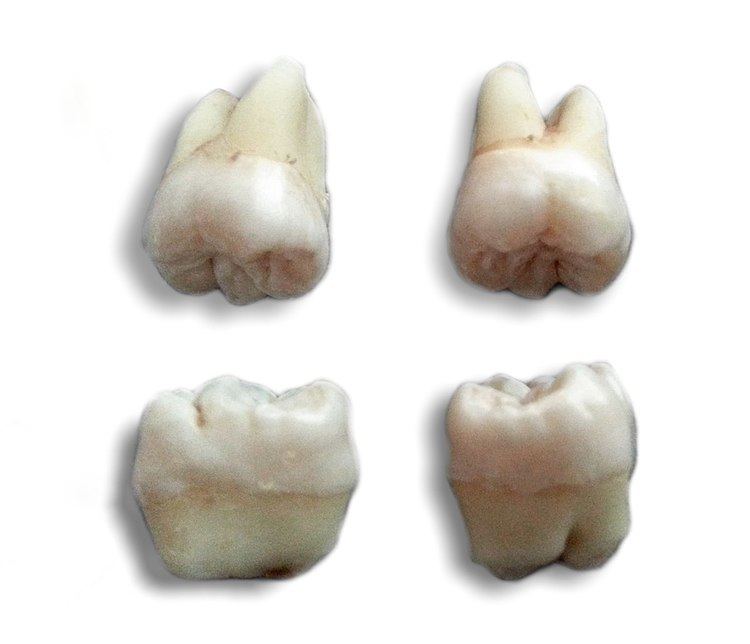TA A05.1.03.008 | ||
 | ||
A wisdom tooth or third molar is one of the three molars per quadrant of the human dentition. It is the most posterior of the three. Wisdom teeth generally erupt between the ages of 17 and 25. Most adults have four wisdom teeth, one in each of the four quadrants, but it is possible to have fewer or more, in which case the extras are called supernumerary teeth. Wisdom teeth commonly affect other teeth as they develop, becoming impacted. They are often extracted when or even before this occurs.
Contents
Variation
Agenesis of wisdom teeth differs by population, ranging from practically zero in Tasmanian Aborigines to nearly 100% in indigenous Mexicans (see research paper with world map showing prevalence). The difference is related to the PAX9 gene (and perhaps other genes).
Function
Wisdom teeth are vestigial third molars that helped human ancestors to grind plant tissue. It is thought that the skulls of human ancestors had larger jaws with more teeth, which possibly helped to chew foliage to compensate for a lack of ability to efficiently digest the cellulose that makes up a plant cell wall. After the advent of agriculture 10 000 years ago, soft human diets became the norm, including carbohydrate and high energy foods. Such diets typically result in jaws growing with less forwards growth than our paleolithic ancestors and not enough room for the wisdom teeth. This is not an evolutionary change, but rather an environmental change.
Clinical significance
Wisdom teeth (often notated clinically as M3 for third molar) have long been identified as a source of problems and continue to be the most commonly impacted teeth in the human mouth. The oldest known impacted wisdom tooth belonged to a European woman of the Magdalenian period (18,000–10,000 BCE). A lack of room to allow the teeth to erupt results in a risk of periodontal disease and dental cavities that increases with age. Less than 2% of adults age 65 years or older maintain the teeth without cavities or periodontal disease and 13% maintain unimpacted wisdom teeth without cavities or periodontal disease.
Impacted wisdom teeth are classified by the direction and depth of impaction, the amount of available space for tooth eruption and the amount soft tissue or bone that covers them. The classification structure allows clinicians to estimate the probabilities of impaction, infections and complications associated with wisdom teeth removal. Wisdom teeth are also classified by the presence of symptoms and disease.
Treatment of an erupted wisdom tooth is the same as any other tooth in the mouth. If impacted, treatment can be localized to the infected tissue overlying the impaction, extraction or coronectomy.
History
Although formally known as third molars, the common name is wisdom teeth because they appear so late – much later than the other teeth, at an age where people are presumably "wiser" than as a child, when the other teeth erupt. The term probably came as a translation of the Latin dens sapientiae. Their eruption has been known to cause dental issues for centuries, it was noted at least as far back as Aristotle:
The last teeth to come in man are molars called 'wisdom-teeth', which come at the age of twenty years, in the case of both sexes. Cases have been known in women upwards of eighty years old where at the very close of life the wisdom-teeth have come up, causing great pain in their coming; and cases have been known of the like phenomenon in men too. This happens, when it does happen, in the case of people where the wisdom-teeth have not come up in early years.
